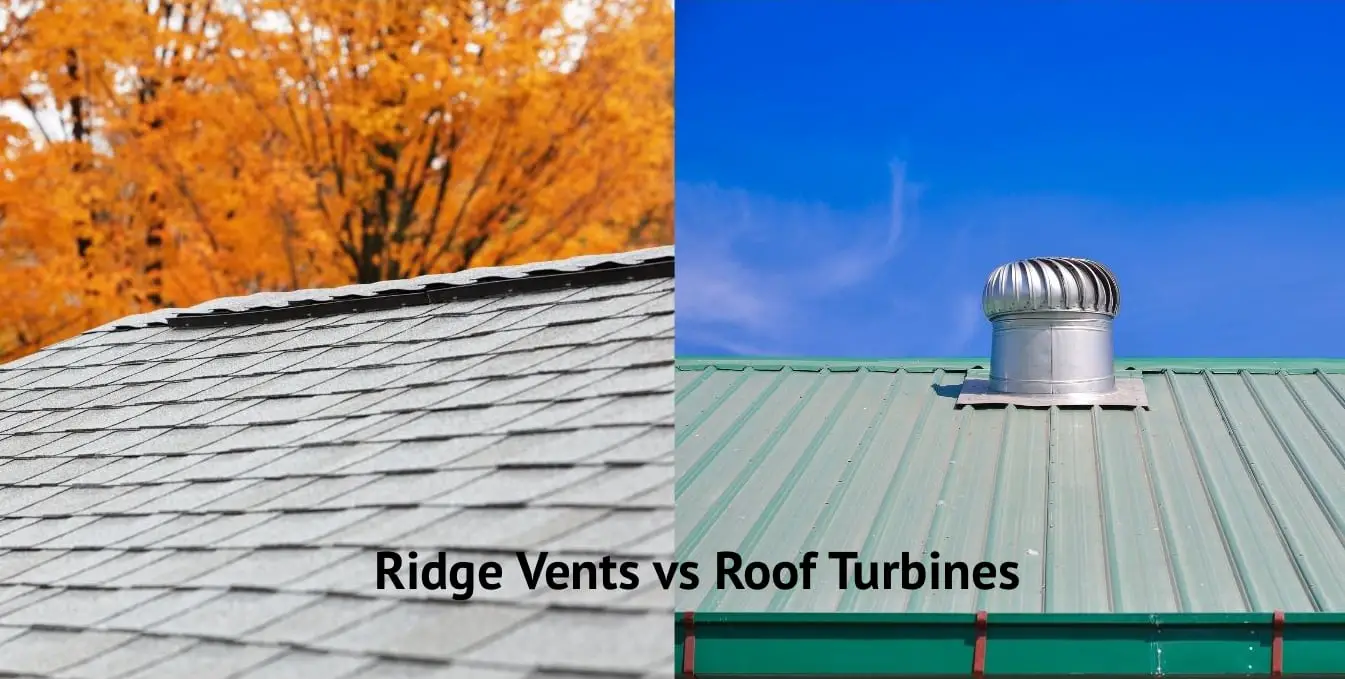There are different types of roof vents for providing attic ventilation. Whirlybirds aka roof turbines, eyebrow vents, ridge vents, gable vents, etc are some of those. But are roof turbines better than the other vents?
The main difference between roof turbines and ridge vents is how they work. Roof turbines rotate while ridge vents are static vents. Roof turbines also move more air than ridge vents even though the area required for their installation is smaller.
Here is the complete list of the differences between whirlybirds and ridge vents;
| Roof Turbine Vents | Ridge vents |
|---|---|
| They have moving parts | They are static vents |
| Turbine vents remove air by active ventilation | Remove air by convection |
| Visible from outside | Hidden from view |
| Move more air than ridge vents | Move less air than whirlybirds |
| Require only a smaller area for installation | Require more area for installation |
| Costs less to install | Costs more to install |
| Require more maintenance compared to ridge vents | Require less maintenance compared to turbine vents |
| Do not work if there is no wind | Work irrespective of the weather conditions |
| Helps to remove more moisture during winter | Removes less moisture during winter compared to roof turbines |
| Chances of rust and mechanical failures | No rust or mechanical failures |
Roof Turbines vs Ridge Vents: A detailed comparison
Roof turbines are those spinning things you see on the roof of houses and commercial spaces whereas ridge vents are shallow vents running along the ridge of the roof. Let’s see in detail the similarities and differences between whirlybird roof turbines and ridge vents.

Roof turbines have moving parts while ridge vents don’t
As you know whirlybirds are turbines on the roof that rotate. They have a fan-like structure that moves with the wind. It is this movement that helps the turbines to suck the air out of the attic.
One the other hand, ridge vents are static vents, they do not move.
Roof turbines remove air by active ventilation while ridge vents do that by passive ventilation
Even though roof turbines do not consume any energy they remove air just like active ventilators. This is because when the wind flows, it moves the fins of the turbine vent making it work as an active ventilator.
But roof ridges work based on the principle of convection of heat. The hot air that rises reaches the top of the attic which is then vented through the ridge vents. This is a passive ventilation method since the hot air is not forced out of the attic but rather it is removed by providing an exit .
Even though the working of roof turbines and ridge vents are different both of them require the presence of air intake vents like soffit vents for their proper working. This is because once the hot air is exhausted from the attic the lack of air there needs to be filled with the cool air from the outside, and soffit vents are the best choice for this.
Ridge vents complement the roof while turbine vents do not
Ridge vents are very shallow even though they run the whole length of the ridge. A typical ridge vent has a height of only one inch or less and it cannot be seen from the outside.
In contrast, you can spot a whirlybird from a mile away. From a distance, they look like large mushrooms sprouted on the roof. To be honest, they are hideous to look at compared to the more sophisticated ridge vents.
Roof turbines move more air than ridge vents
Under the right conditions, a whirlybird can move considerably more air than a ridge vent. A turbine vent will rotate at even a small wind which sucks out the air from the attic. The more the wind the more powerful will be its venting.
Since ridge vents depend on the convection of heat they almost always move the same amount of air out. A wind blowing over the ridge vent can create a low pressure on the leeward side accelerating air removal but the volume of air moved even then is not as much as that of a wind turbine.
Roof turbines require only a small area for installation and they cost less
Roof turbines need only a smaller area for their installation when compared to ridge vents. To install a turbine vent you only have to remove a few square feet of shingles whereas to install ridge vents you will have to remove all the shingles along the ridgeline.
Here is a video showing the installation of a roof turbine vent;
Not only roof turbines require a small area for installation they are also cheaper to install when compared to ridge vents. Since ridge vents run along the full length of the ridges it takes a lot more time and effort than the installation of a wind turbine where you need to remove only a few shingles.
Roof turbines require more maintenance than ridge vents
As you know roof turbines have moving parts. They are also made of metal which is likely to rust whereas ridge vents don’t have any such issues. Therefore roof turbines require more maintenance than ridge vents.
But even though roof turbines require more maintenance than ridge vents it doesn’t mean you need to do that very often, yearly maintenance is more than enough to run the turbines without any trouble for years.
In terms of longevity ridge vents trump turbine vents however, there are turbine vents that have been working for over 25 years so longevity is not a concern for both of these attic exhaust vents.
Roof turbines do not work when there is no wind
One major difference between roof turbine and ridge vents is that the former doesn’t work of there is no wind. Roof turbines exhaust air due to the spinning action of their blades which is caused by outside wind movement. When there is no wind blowing the turbine will remain stationary not moving any attic air. Since ridge vents work based on convection they work irrespective of the weather conditions. Whether there is wind or not the hot air inside the attic will always rise and vent through the ridge vents. If there is no hot air to rise then this system won’t work but in such cases, there is no need for attic ventilation, does it?
Roof turbines are more effective in winter than ridge vents
As mentioned before roof turbines can vent more volume of air at a time than ridge vents. Since ridge vents work on the principle of convection they are not very effective during winter. But during winter times it is important that attics have ventilation in order to remove moisture. Moisture buildup during winter months can lead to the growth of mold and fungus, things you don’t want in your attic. Since turbine vents work whenever there is wind irrespective of the season, they are more effective during winter.
Some people have a concern that wind turbines will remove heat from the house during winter. If your attic is a ventilated one ie, if there is no heat insulation on the roof then it should have ventilation nevertheless. In such cases, the floor of the attic is insulated so this will prevent any heat from escaping. This means that the house will stay warm while the attic is cold, as it is designed to be.
Using ridge vents and turbine vents together
Now that you know the differences between turbine and roof vents, another question that may come to your mind is whether both of these can be used together.
You can use ridge and turbine vents together if you have extra ventilation requirements. Roof ridge vents and turbines complement each other. Using them together will increase the attic ventilation.
It is natural to think that turbines can hinder the working of ridge vents like attic fans do. (Please read more on attic fans vs ridge vents to know how having attic fans can adversely affect ventilation). But since wind turbines are not mechanically powered, they do not have enough power to suck air through the ridge vents. Therefore, having both types of vents will not reduce attic airflow.
Which is a better choice; Roof turbines or ridge vents?
Both roof turbines and ridge vents are great options for ventilating an attic. The answer to which one of them is better depends on your preferences and where you live. If you need vents that do not visually affect the roof then your only option is a ridge vent. Also if you live in an area that doesn’t have much wind movement, again, ridge vents are the only option.
On the other hand, if you care more about performance and you are located in an area with mild winds roof turbines are a great choice for your attic ventilation.
Similar articles:

